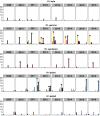The genomic evolution of H1 influenza A viruses from swine detected in the United States between 2009 and 2016
- PMID: 28758634
- PMCID: PMC5817270
- DOI: 10.1099/jgv.0.000885
The genomic evolution of H1 influenza A viruses from swine detected in the United States between 2009 and 2016
Abstract
Transmission of influenza A virus (IAV) from humans to swine occurs with relative frequency and is a critical contributor to swine IAV diversity. Subsequent to the introduction of these human seasonal lineages, there is often reassortment with endemic viruses and antigenic drift. To address whether particular genome constellations contributed to viral persistence following the introduction of the 2009 H1N1 human pandemic virus to swine in the USA, we collated and analysed 616 whole genomes of swine H1 isolates. For each gene, sequences were aligned, the best-known maximum likelihood phylogeny was inferred, and each virus was assigned a clade based upon its evolutionary history. A time-scaled Bayesian approach was implemented for the haemagglutinin (HA) gene to determine the patterns of genetic diversity over time. From these analyses, we observed an increase in genome diversity across all H1 lineages and clades, with the H1-γ and H1-δ1 genetic clades containing the greatest number of unique genome patterns. We documented 74 genome patterns from 2009 to 2016, of which 3 genome patterns were consistently detected at a significantly higher level than others across the entire time period. Eight genome patterns increased significantly, while five genome patterns were shown to decline in detection over time. Viruses with genome patterns identified as persisting in the US swine population may possess a greater capacity to infect and transmit in swine. This study highlights the emerging genetic diversity of US swine IAV from 2009 to 2016, with implications for swine and public health and vaccine control efforts.
Conflict of interest statement
The authors declare that there are no conflicts of interest.
Figures



Similar articles
-
Influenza A Viruses of Swine (IAV-S) in Vietnam from 2010 to 2015: Multiple Introductions of A(H1N1)pdm09 Viruses into the Pig Population and Diversifying Genetic Constellations of Enzootic IAV-S.J Virol. 2016 Dec 16;91(1):e01490-16. doi: 10.1128/JVI.01490-16. Print 2017 Jan 1. J Virol. 2016. PMID: 27795418 Free PMC article.
-
Spatiotemporal Distribution and Evolution of the A/H1N1 2009 Pandemic Influenza Virus in Pigs in France from 2009 to 2017: Identification of a Potential Swine-Specific Lineage.J Virol. 2018 Nov 27;92(24):e00988-18. doi: 10.1128/JVI.00988-18. Print 2018 Dec 15. J Virol. 2018. PMID: 30258006 Free PMC article.
-
Characterization of co-circulating swine influenza A viruses in North America and the identification of a novel H1 genetic clade with antigenic significance.Virus Res. 2015 Apr 2;201:24-31. doi: 10.1016/j.virusres.2015.02.009. Epub 2015 Feb 18. Virus Res. 2015. PMID: 25701742
-
[Swine influenza virus: evolution mechanism and epidemic characterization--a review].Wei Sheng Wu Xue Bao. 2009 Sep;49(9):1138-45. Wei Sheng Wu Xue Bao. 2009. PMID: 20030049 Review. Chinese.
-
Implications of segment mismatch for influenza A virus evolution.J Gen Virol. 2018 Jan;99(1):3-16. doi: 10.1099/jgv.0.000989. Epub 2017 Dec 15. J Gen Virol. 2018. PMID: 29244017 Free PMC article. Review.
Cited by
-
Continued evolution of the Eurasian avian-like H1N1 swine influenza viruses in China.Sci China Life Sci. 2023 Feb;66(2):269-282. doi: 10.1007/s11427-022-2208-0. Epub 2022 Oct 9. Sci China Life Sci. 2023. PMID: 36219302
-
Antigenic Characterization and Pandemic Risk Assessment of North American H1 Influenza A Viruses Circulating in Swine.Microbiol Spectr. 2022 Dec 21;10(6):e0178122. doi: 10.1128/spectrum.01781-22. Epub 2022 Nov 1. Microbiol Spectr. 2022. PMID: 36318009 Free PMC article.
-
Complete Genome Sequences of Two Novel Human-Like H3N2 Influenza A Viruses, A/swine/Oklahoma/65980/2017 (H3N2) and A/Swine/Oklahoma/65260/2017 (H3N2), Detected in Swine in the United States.Microbiol Resour Announc. 2018 Nov 21;7(20):e01203-18. doi: 10.1128/MRA.01203-18. eCollection 2018 Nov. Microbiol Resour Announc. 2018. PMID: 30533826 Free PMC article.
-
Swine influenza virus: Current status and challenge.Virus Res. 2020 Oct 15;288:198118. doi: 10.1016/j.virusres.2020.198118. Epub 2020 Aug 13. Virus Res. 2020. PMID: 32798539 Free PMC article. Review.
-
Effect of strain-specific maternally-derived antibodies on influenza A virus infection dynamics in nursery pigs.PLoS One. 2019 Jan 14;14(1):e0210700. doi: 10.1371/journal.pone.0210700. eCollection 2019. PLoS One. 2019. PMID: 30640929 Free PMC article.
References
-
- Scholtissek C. Pigs as ‘Mixing vessels’ for the creation of new pandemic influenza A viruses. Med Princ Pract. 1990;2:65–71. doi: 10.1159/000157337. - DOI
MeSH terms
Substances
Grants and funding
LinkOut - more resources
Full Text Sources
Other Literature Sources

